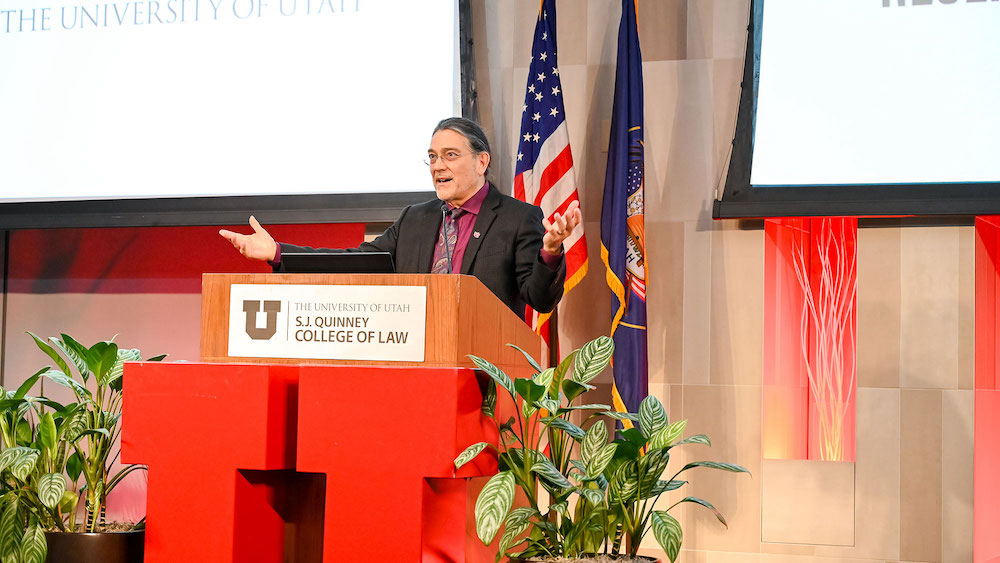Census Bureau director visits the U
 “Dad, meeting Director Santos is a bigger deal than meeting Taylor Swift.”
“Dad, meeting Director Santos is a bigger deal than meeting Taylor Swift.”
President Taylor Randall chuckled along with attendees at the annual conference of the U.S. Census National Federal Statistical Research Data Centers (FSRDC), a national network of 33 centers that facilitate access to confidential data for scholarly research. As Taylor introduced keynote speaker Robert L. Santos, the 26th and first Latino director of the U.S. Census Bureau, he shared his daughter’s super-fandom of the rockstar of federal statistics.
“At the bottom of my daughter’s CV, it says, ‘I am a census enthusiast,’” Randall said. “I grew mightily in her eyes today for the fact that I get to actually introduce the census director.”
Santos spoke to a packed room at the S.J. Quinney School of Law’s moot courtroom that included representatives from every RDC in the country. This year’s conference showcased the University of Utah-based Wasatch Front Research Data Center (WFRDC). Serving the Intermountain West since 2020, the WFRDC has become a pivotal hub for data-driven research vital to improving our understanding of the nation’s population and economy. Santos shared how the WFRDC’s work fits into the Bureau’s community-of-the-whole, a massive engagement effort that has Santos and his team traveling the nation to connect with current and potential data users and to get feedback directly from local communities.
“We know the value and the importance of different perspectives, so we’re out there to go get them by actively including diverse thinkers both within our career staff and externally with stakeholders,” Santos said. “The Census Bureau’s transformation and modernization efforts require more than the latest technology or statistical methods. We must also transform how we think about data in a rapidly evolving society and how the needs of the public can be met.”
The NEXUS of data and people’s lives
An RDC is a boon for researchers who study the challenges facing contemporary Americans across all sectors, including health, business, demography, economics and sociology. RDC datasets are the gold standard for social science research due to their extreme detail. Throughout the conference, researchers shared their RDC-supported projects, including the injury risk associated with subcontracting in U.S. construction from Kevin Connor of the U’s Department of Economics and the effect of female directors on workplace gender diversity, women’s earnings and promotion outcomes from Elena Patel of the U’s David Eccles School of Business. The data have individual-level information gleaned from federal censuses, surveys of businesses and households, linked employer-employee data, and records from state and federal agencies and other sources.

PHOTO CREDIT: Elizabeth Johnson, CSBS
From left to right: Lori Kowaleski-Jones, director of NEXUS and the WFRDC, Robert
Santos, director of the U.S. Census Bureau, Michelle Camacho, dean of the College
of Social and Behavioral Sciences.
To Michelle Camacho, dean of the College of Social and Behavioral Sciences (CSBS), these datasets represent personal stories. She opened the conference by reflecting on her journey to becoming a social scientist specializing in the inequities in higher education. She grew up in Garden Grove, a working-class area in Orange County, as a daughter of a Bolivian immigrant and was the first in her family to attend college.
“My own personal story can be reflected in some of the census data from my hometown,” she said.
The region used to be an agricultural community of orange groves. Now, it’s transformed into Latino and Vietnamese ethnic enclaves with manufacturing and the service industry as primary economic drivers, she continued.
“As an educator, I ask myself, ‘How can I help students use their own narratives to be curious about their social world?’ We hold a responsibility for championing the power that data provides to ourselves, to our students, and to our communities.”
Training a statistical data workforce
The U-based WFRDC is housed within the Interdisciplinary Exchange for Utah Science (NEXUS), a research center aimed to address society’s grand challenges by promoting interdisciplinary research and team science. NEXUS’s mission is to democratize data by expanding access to researchers and students to better understand issues in their communities. CSBS and NEXUS recently received a $2 million grant from the National Science Foundation, which will provide two-year scholarships to 31 graduate students. The program will adapt mentorship strategies to promote success, develop workshops to democratize data access and analysis and engage in industry partnerships to provide a pool of skilled professionals to fill the urgent need for a growing data-science workforce.
“NEXUS and the WFRDC are at the forefront of efforts to provide the data science skills needed to thrive in a changing workforce,” said Lori Kowaleski-Jones, director of NEXUS and the WFRDC who is co-principal investigator of the NSF grant, with Camacho as principal investigator. “Opportunities for high-impact analyses utilizing restricted-use confidential data that the Census Bureau and its partner agencies make available through the FSRDC network are only available here at the University of Utah and serve researchers across the Mountain West researchers region.”
Kowaleski-Jones and campus leadership are also pursuing creative partnerships with the U.S. Census Bureau to support collaboration and expand opportunities for students to thrive in data science careers. The two are in talks to enter a memorandum of understanding with the goal of graduating students to be well-prepared to pursue data science-related and mission-critical positions with the Bureau and beyond.
“Our society is hungry for more data all the time, and it translates to increased and sometimes urgent stakeholder needs from the bureau,” said Santos. “Our 21st-century statistical universe features increasingly sophisticated data users, like the kinds that visit your federal statistical research data centers. They intensify our challenges in the collection, processing and curation of data, and in creating new data products that fit those newly sophisticated data-user needs.”
About the Blog
Discussion channel for insightful chat about our events, news, and activities.
